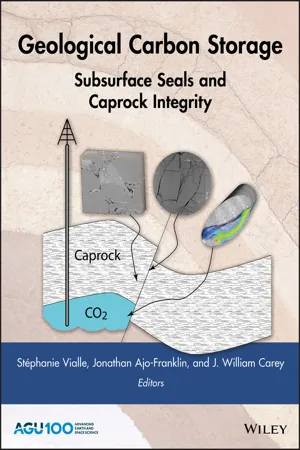
Geological Carbon Storage
Subsurface Seals and Caprock Integrity
- English
- ePUB (mobile friendly)
- Available on iOS & Android
Geological Carbon Storage
Subsurface Seals and Caprock Integrity
About This Book
Geological Carbon Storage Subsurface Seals and Caprock Integrity
Seals and caprocks are an essential component of subsurface hydrogeological systems, guiding the movement and entrapment of hydrocarbon and other fluids. Geological Carbon Storage: Subsurface Seals and Caprock Integrity offers a survey of the wealth of recent scientific work on caprock integrity with a focus on the geological controls of permanent and safe carbon dioxide storage, and the commercial deployment of geological carbon storage.
Volume highlights include:
- Low-permeability rock characterization from the pore scale to the core scale
- Flow and transport properties of low-permeability rocks
- Fundamentals of fracture generation, self-healing, and permeability
- Coupled geochemical, transport and geomechanical processes in caprock
- Analysis of caprock behavior from natural analogues
- Geochemical and geophysical monitoring techniques of caprock failure and integrity
- Potential environmental impacts of carbon dioxide migration on groundwater resources
- Carbon dioxide leakage mitigation and remediation techniques
Geological Carbon Storage: Subsurface Seals and Caprock Integrity is an invaluable resource for geoscientists from academic and research institutions with interests in energy and environment-related problems, as well as professionals in the field.
Frequently asked questions
Information
Part I
Caprock Characterization
1
Microstructural, Geomechanical, and Petrophysical Characterization of Shale Caprocks
ABSTRACT
Geological storage of carbon dioxide requires extensive characterization of potential selected sites in terms of injectivity, storage capacity, and containment integrity. The latter item on that list requires a multi‐scale evaluation of all aspects of the subsurface geology that can trap CO2 underground and keep it there long term. One part of a containment integrity strategy includes characterization of the caprock at a given site. Many selected sites have clay‐rich shales as caprocks, and this contribution will concentrate on workflows and methods for characterizing such rocks in the laboratory. Shale preservation is the most critical step in the process as dehydration from the native in situ water content significantly affects shale properties. Various mineralogical, microscopical, petrophysical, and geomechanical properties and associated testing methods are discussed, and where possible, examples are shown of the impact of lack of preservation. Results are discussed in the context of interaction of CO2 with caprocks and trapping mechanisms. Finally, the discussion looks at a number of the uncertainties associated with laboratory testing of shales in terms of both results obtained to date and our limited understanding as yet of the behavior and interaction of supercritical CO2 with clay‐rich caprocks.
1.1. INTRODUCTION
1.2. SHALE PRESERVATION
Table of contents
- Cover
- Table of Contents
- PREFACE
- Part I: Caprock Characterization
- Part II: Fracture Generation, Permeability, and Geochemical Reactions in Damaged Shale
- Part III: Monitoring Caprock Failure
- Part IV: Environmental Impacts and Remediation Techniques
- INDEX
- End User License Agreement